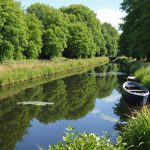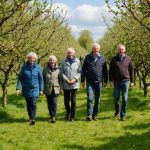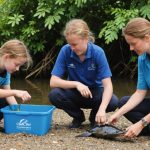Importance of Traditional Orchards
Traditional orchards hold immense ecological significance within local ecosystems. These orchards are not only beautiful landscapes but vital habitats that support a diverse range of species, fostering innovative biodiversity. From birds to insects and mammals, many species find shelter and sustenance in these varied environments. This means traditional orchards play a pivotal role in maintaining the ecological balance by supporting biodiversity.
The benefits of biodiversity in traditional orchards are profound. They offer natural pest control, reduce the need for chemical interventions, and enhance pollination through the presence of diverse wildlife. This contributes to the overall health and sustainability of agricultural practices. Moreover, traditional orchards serve as genetic reserves, preserving heirloom fruit varieties that might otherwise be lost.
Lire également : Enhancing Biodiversity: Effective Management Strategies for the UK’s Canal Networks to Support Vibrant Aquatic Ecosystems
Furthermore, traditional orchards are deeply linked to cultural heritage. They are living testaments to historical agricultural practices and serve as cultural landmarks, chronicling the evolution of farming techniques and community development over centuries. By maintaining and valuing these orchards, communities uphold traditions and nurture a relationship with nature that has been passed down through generations. Thus, traditional orchards not only bolster ecological integrity but also enrich cultural identity.
Community Engagement in Conservation Efforts
In the landscape of conservation, community involvement plays a pivotal role. Local residents often bring unique insights and dedicated efforts to conservation strategies, making them indispensable allies. Grassroots initiatives actively contribute to safeguarding endangered orchards by addressing specific local challenges.
Avez-vous vu cela : Exploring Educational Initiatives for UK Children: Marine Conservation Awareness Programs
One compelling example is the success story of community-led orchard restoration projects. These local initiatives enlist volunteers and enthusiasts to rehabilitate and maintain fruit-bearing trees, fostering a thriving ecosystem. By cultivating a sense of ownership, communities are empowered to protect their natural resources efficiently.
Residents seeking to initiate their own conservation efforts should follow a series of straightforward steps. Firstly, identifying key stakeholders within the community can provide essential support and guidance. Secondly, forming a plan tailored to the local environment and its specific needs is crucial. Engaging with local conservation organisations can offer valuable resources and knowledge, enhancing the project’s potential for success.
Moreover, promoting community involvement through workshops and events raises awareness and garners support. This heightened connection among residents stimulates sustainable practices and long-term commitment. Engaged communities not only protect their natural surroundings but also nurture a shared sense of purpose and pride in their environment, exemplifying a model for effective conservation.
Actionable Strategies for Safeguarding Orchards
To ensure the longevity and productivity of orchards, a proactive approach blending practical steps from diverse areas of orchard management is vital. These strategies not only improve the orchard’s yield but also contribute to the greater good of wildlife protection.
Maintenance Practices for Traditional Orchards
Traditional orchards require specific maintenance practices to thrive over time. Regular pruning not only boosts fruit production but also maintains tree health. Pruning ensures that the canopy does not become too dense, allowing light and air to circulate effectively. This reduces pest issues and encourages biodiversity within your orchard.
Fostering Wildlife Habitats
Integrating wildlife protection strategies is essential for orchard sustainability. By fostering wildlife habitats within your orchard, you attract beneficial insects and birds that aid in pest control. Planting hedgerows or wildflower strips around the orchard serves as a habitat for these allies, enhancing the natural balance between crops and wildlife.
Implementing Organic Cultivation Methods
Adopting organic cultivation methods provides numerous benefits. Using natural fertilisers and avoiding chemical pesticides helps preserve soil quality and encourages biodiversity. This approach not only nurtures the orchard’s ecosystem but also results in healthier produce. Sustainable orchard management through organic practices is essential for maintaining a healthy environment for generations to come.
Case Studies of Successful Initiatives
Exploring success stories within traditional orchard projects reveals insightful case studies that offer valuable lessons. In the UK, several community projects have flourished, significantly impacting local biodiversity and ecosystems. One notable example is a project that transformed a neglected orchard into a thriving green space. This initiative not only rejuvenated the area’s natural beauty but also increased the diversity of flora and fauna through planting native fruit trees and creating habitats for various species.
Analyzing these case studies highlights several common factors contributing to their success. Crucially, projects that engaged local communities from the outset tended to fare better. Community involvement ensures sustainable upkeep and fosters a sense of ownership and responsibility. Furthermore, understanding the specific ecological requirements of each site allowed these initiatives to tailor conservation efforts effectively, enhancing their impact on local ecosystems.
Lessons learned from these successful initiatives emphasize the importance of robust planning, community engagement, and adaptability. By sharing their experiences, these projects offer a framework for others seeking similar outcomes in preserving biodiversity. These best practices, like facilitating education and awareness, guide future endeavors and promote environmental stewardship, ensuring traditional orchards continue to play a vital role in maintaining ecosystem health.
Partnerships with Local Organizations
Collaborative efforts between orchards and local organizations play a crucial role in boosting preservation initiatives. Engaging with conservation groups and NGOs not only provides access to expert resources but also facilitates the implementation of sustainable practices. These partnerships can assist orchards in implementing eco-friendly technologies, such as optimized irrigation systems, to maximize yields without harming the environment.
Government programs also support orchard preservation through grants and technical assistance. These initiatives focus on sustainable agriculture, offering orchards the financial backing and know-how required to adhere to environmentally sound practices. By participating in these programs, orchards can achieve better resilience against climate changes and market fluctuations.
Approaching potential partners requires clear communication and shared goals. Start by identifying organizations whose missions align with orchard preservation. Engage with these entities by demonstrating the unique value that a potential collaboration can bring to both parties. Building relationships through regular communication and site visits can significantly increase the probability of successfully securing partnerships. Propose solutions and projects that align with the goals and values of both the orchard and the partner organization, ensuring mutual benefits and stronger commitments. Strategic collaborations are pivotal for orchards seeking long-term sustainability and conservation success.
Legal and Policy Framework Supporting Conservation
Understanding the legal landscape surrounding conservation is crucial for effective environmental protection. Orchards, with their vital ecological functions, enjoy support through various conservation laws. The Wildlife and Countryside Act 1981 is one such framework in the UK that oversees the protection of wildlife and habitats, including those found within traditional orchards. Moreover, policies such as the Biodiversity Action Plan emphasize preserving habitats at risk.
Citizens play a pivotal role in conservation. Resources are available to help them understand their rights and responsibilities. Online databases and libraries provide access to vital documents and maps of designated conservation areas. These tools empower individuals to ensure that their activities align with policy support and contribute positively to the environment.
Advocating for stronger protection measures can be achieved by engaging with local councils and conservation groups. Writing petitions or participating in environmental forums can bring attention to the importance of orchards. Public consultations are opportunities to voice concerns and suggest policy enhancements. Fostering collaboration between local authorities and residents supports not only the conservation of natural habitats but also ensures effective policy implementation, providing a robust defense against ecological threats.
Visual Resources and Educational Tools
Visual aids play a pivotal role in fostering conservation awareness about traditional orchards. Infographics serve as one of the most effective educational resources for communities. They can succinctly communicate complex information, making it more approachable and memorable. These visuals often illustrate the biodiversity present in traditional orchards or highlight key conservation strategies.
Educational resources extend beyond infographics, incorporating workshops that actively engage citizens in conservation efforts. Workshops can focus on hands-on activities such as planting techniques or biodiversity assessments, empowering individuals to contribute positively to orchard preservation. Additionally, events like community orchard days encourage local involvement through informative presentations and interactive sessions.
To foster a deep understanding and appreciation for traditional orchards, communities might consider incorporating diverse learning formats. This can include guided tours that offer insights into the ecological significance of these habitats or digital platforms where participants can access e-learning modules and virtual orchard experiences.
Conservation awareness thrives when communities are equipped with engaging and informative tools. By blending visual resources with practical educational approaches, traditional orchard conservation becomes a shared responsibility that is both enlightening and actionable. This approach ensures that the knowledge gained is retained and transformed into meaningful conservation actions.











